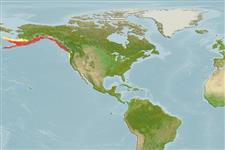Common names from other countries
Teleostei (teleosts) >
Perciformes/Cottoidei (Sculpins) >
Agonidae (Poachers) > Bathyagoninae
Etymology: Bathyagonus: Greek, bathys = deep + Greek, gonos, gone = birth (Ref. 45335); alascanus: Named after the type locality, Alaska (Ref. 6885).
More on author: Gilbert.
Environment: milieu / climate zone / depth range / distribution range
Ecology
Marine; demersal; depth range 18 - 252 m (Ref. 2850). Temperate; 62°N - 42°N, 178°W - 120°W (Ref. 57303)
Eastern Pacific: Bering Sea coast of Alaska to the Oregon-California border, USA.
Size / Weight / Age
Maturity: Lm ? range ? - ? cm
Max length : 13.0 cm TL male/unsexed; (Ref. 2850)
Dorsal spines (total): 5 - 8; Dorsal soft rays (total): 5 - 7; Anal spines: 0; Anal soft rays: 6 - 8. Dorsal fins moderately developed and placed fairly close together; caudal rounded; anal fin originating about halfway below interspace between dorsal fins; pectoral fins with lower 5 0r 6 rays extending well beyond membrane; pelvic fins reduced (Ref. 6885). Greenish gray to light brown on dorsal surface, very light brown on ventral surface; 5 or 6 dark brown saddle-like markings across back and on sides; dark brown bars on dorsal and caudal fins; paired fins light (Ref. 6885).
Inhabits rocky areas (Ref. 2850).
Life cycle and mating behavior
Maturities | Reproduction | Spawnings | Egg(s) | Fecundities | Larvae
Eschmeyer, W.N., E.S. Herald and H. Hammann, 1983. A field guide to Pacific coast fishes of North America. Boston (MA, USA): Houghton Mifflin Company. xii+336 p. (Ref. 2850)
IUCN Red List Status (Ref. 130435)
CITES (Ref. 128078)
Not Evaluated
Threat to humans
Harmless
Human uses
Tools
Special reports
Download XML
Internet sources
Estimates based on models
Preferred temperature (Ref.
115969): 3.2 - 7.9, mean 4.9 (based on 215 cells).
Phylogenetic diversity index (Ref.
82804): PD
50 = 0.5625 [Uniqueness, from 0.5 = low to 2.0 = high].
Bayesian length-weight: a=0.00389 (0.00180 - 0.00842), b=3.12 (2.94 - 3.30), in cm Total Length, based on all LWR estimates for this body shape (Ref.
93245).
Trophic level (Ref.
69278): 3.2 ±0.4 se; based on size and trophs of closest relatives
Resilience (Ref.
120179): High, minimum population doubling time less than 15 months (Preliminary K or Fecundity.).
Fishing Vulnerability (Ref.
59153): Low vulnerability (10 of 100).
